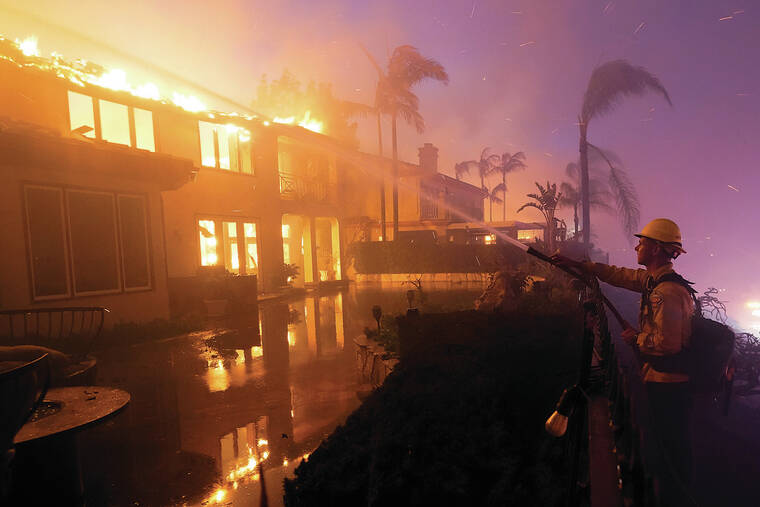‘Like an inferno:’ US West burning at furious pace so far
LAGUNA NIGUEL, Calif. — Wildfires are on a furious pace early this year — from a California hilltop where mansions with multimillion-dollar Pacific Ocean views were torched to remote New Mexico mountains charred by a month-old monster blaze.
The two places could not be more different, but the elements in common are the same: wind-driven flames have torn through vegetation that is extraordinarily dry from years-long drought exacerbated by climate change.
ADVERTISING
As the unstoppable northern New Mexico wildfire chewed through more dense forest Thursday, firefighters in the coastal community of Laguna Niguel doused charred and smoldering remains of 20 large homes that quickly went up in flames and forced a frantic evacuation.
“The sky, everything was orange. It looked like an inferno, so we just jumped in the car,” Sassan Darian said, as he recounted fleeing with his daughter and father while embers swirled around them. “My daughter said, ‘We’re on fire.’ There were sparks on her and we were patting ourselves down.”
Nationwide, more than 2,000 square miles (5,180 square kilometers) have burned so far this year — the most at this point since 2018, according to the National Interagency Fire Center. Predictions for the rest of the spring do not bode well for the West, with the drought and warmer weather brought on by climate change worsening wildfire danger.
“We all know it’s really early for our fire season and we’re all in awe of what we’ve already experienced … to this point,” said Dave Bales, commander on the New Mexico fire that is the largest burning in the U.S. Fire officials said there was not much they could do in recent days to stop the fast-moving flames burning in tinder-dry forests in the Sangre de Christo range.
Fueled by overgrown mountainsides covered with Ponderosa pine and other trees sucked dry of moisture over decades, it’s now burned across more than 405 square miles (1,048 square kilometers) — an area bigger than the city of Dallas, Texas.
Crews fighting flames along the mountain fronts between Santa Fe and Taos mostly held their own on Thursday thanks to welcome help from aerial attacks.
Even small fires that once would have been easily contained are extreme threats to life and property because of climate change, said Brian Fennessy, chief of the Orange County Fire Authority.
The perfect example broke out Wednesday afternoon when flames that may have been sparked by electric utility equipment were pushed up a canyon by strong sea breezes and quickly ignited large homes.
They burned a relatively small area — about 200 acres — but left a large path of destruction.
A sprawling estate selling for $9.9 million had looked in real estate listings like a California dream: teeming with luxuries that included a two-level library, a “wellness wing” with sauna and steam room and a pool.
By nightfall, the mansion once photographed against a pastel sunset had morphed into a nightmare: its arched facade silhouetted against a glowing yellow sky as firefighters trained their hoses on the engulfed structure.


